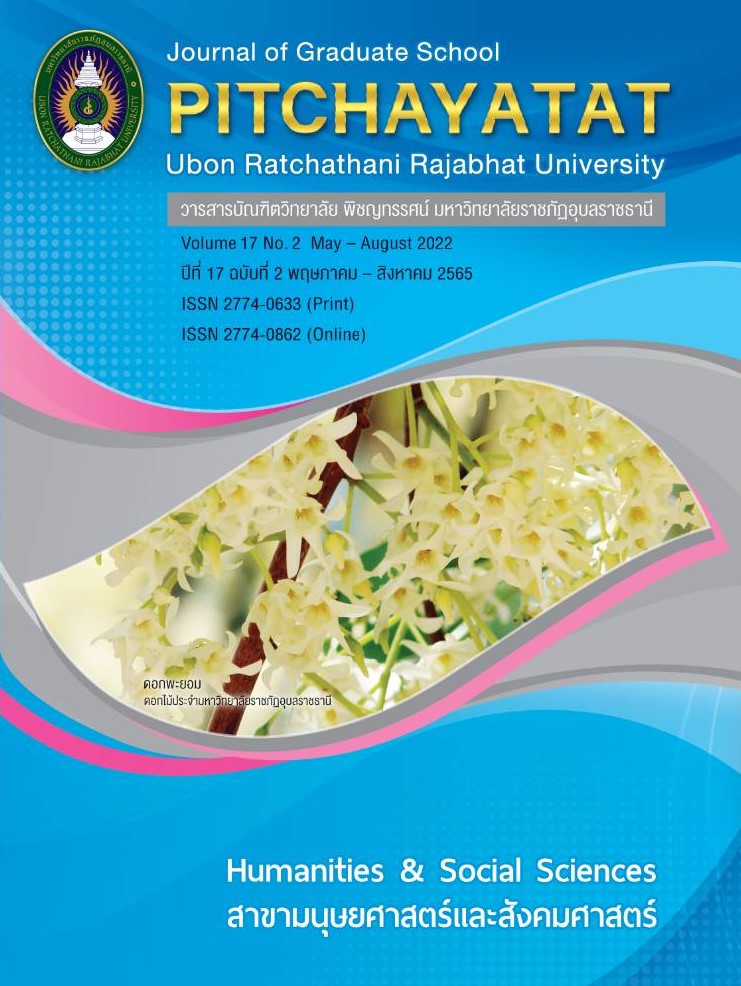ผลการจัดกิจกรรมการเรียนรู้โดยใช้ปัญหาเป็นฐานร่วมกับกระบวนการแก้ปัญหา DAPIC ที่มีต่อทักษะการแก้ปัญหาและทักษะการเชื่อมโยงทางคณิตศาสตร์ ของนักเรียนชั้นประถมศึกษาปีที่ 6
คำสำคัญ:
กิจกรรมการเรียนรู้โดยใช้ปัญหาเป็นฐาน, กระบวนการแก้ปัญหา DAPIC , ทักษะการแก้ปัญหาทางคณิตศาสตร์, ทักษะการเชื่อมโยงทางคณิตศาสตร์บทคัดย่อ
การวิจัยครั้งนี้มีวัตถุประสงค์เพื่อ 1) เปรียบเทียบทักษะการแก้ปัญหาทางคณิตศาสตร์ของนักเรียนชั้นประถมศึกษาปีที่ 6 ที่ได้รับการจัดกิจกรรมการเรียนรู้โดยใช้ปัญหาเป็นฐานร่วมกับกระบวนการแก้ปัญหา DAPIC กับเกณฑ์ร้อยละ 70 2) เปรียบเทียบทักษะการเชื่อมโยงทางคณิตศาสตร์ของนักเรียนชั้นประถมศึกษาปีที่ 6 ที่ได้รับการจัดกิจกรรมการเรียนรู้โดยใช้ปัญหาเป็นฐานร่วมกับกระบวนการแก้ปัญหา DAPIC กับเกณฑ์ร้อยละ 70 ตัวอย่างที่ใช้ เป็นนักเรียนชั้นประถมศึกษาปีที่ 6/1 จำนวน 24 คน ซึ่งได้มาจากการสุ่มแบบแบ่งกลุ่ม เครื่องมือที่ใช้ประกอบด้วย 1) แผนการจัดกิจกรรมการเรียนรู้โดยใช้ปัญหาเป็นฐานร่วมกับกระบวนการแก้ปัญหา DAPIC 2) แบบทดสอบวัดทักษะการแก้ปัญหาและทักษะการเชื่อมโยงทางคณิตศาสตร์ เรื่อง รูปสามเหลี่ยมและรูปหลายเหลี่ยม สถิติที่ใช้ ได้แก่ ค่าเฉลี่ย ส่วนเบี่ยงเบนมาตรฐาน และการทดสอบที
ผลการวิจัยพบว่า
- ทักษะการแก้ปัญหาทางคณิตศาสตร์ของนักเรียนชั้นประถมศึกษาปีที่ 6 ที่ได้รับการจัดกิจกรรมการเรียนรู้โดยใช้ปัญหาเป็นฐานร่วมกับกระบวนการแก้ปัญหา DAPIC สูงกว่าเกณฑ์ร้อยละ 70 อย่างมีนัยสำคัญทางสถิติที่ระดับ .05
- ทักษะการเชื่อมโยงทางคณิตศาสตร์ของนักเรียนชั้นประถมศึกษาปีที่ 6 ที่ได้รับการจัดกิจกรรมการเรียนรู้โดยใช้ปัญหาเป็นฐานร่วมกับกระบวนการแก้ปัญหา DAPIC สูงกว่าเกณฑ์ร้อยละ 70 อย่างมีนัยสำคัญทางสถิติที่ระดับ .05
เอกสารอ้างอิง
เวชฤทธิ์ อังกนะภัทรขจร. ครบเครื่องเรื่องควรรู้สำหรับครูคณิตศาสตร์. กรุงเทพฯ: จรัลสนิทวงศ์การพิมพ์, 2555.
ศึกษาธิการ, กระทรวง. ตัวชี้วัดและสาระการเรียนรู้แกนกลางกลุ่ม สาระการเรียนรู้คณิตศาสตร์ (ฉบับปรังปรุง พ.ศ. 2560) ตามหลักสูตรแกนกลางการศึกษาขั้นพื้นฐาน พุทธศักราช 2551. กรุงเทพฯ: โรงพิมพ์ชุมนุมสหกรณ์การเกษตรแห่งประเทศไทย, 2560.
ศึกษาธิการ, กระทรวง. หลักสูตรแกนกลางการศึกษาขั้นพื้นฐาน พุทธศักราช 2551. กรุงเทพฯ: โรงพิมพ์ชุมนุมสหกรณ์การเกษตรแห่งประเทศไทย, 2551.
ส่งเสริมการสอนวิทยาศาสตร์และเทคโนโลยี, สถาบัน. การวัดและประเมินผลคณิตศาสตร์. กรุงเทพฯ: ซีเอ็ดยูเคชั่น, 2555.
ส่งเสริมการสอนวิทยาศาสตร์และเทคโนโลยี, สถาบัน. ตัวอย่างข้อสอบที่ใช้ในการประเมินผลการเรียนรู้วิชาคณิตศาสตร์ ตามโครงการวิจัยนานาชาติ TIMSS 2007. กรุงเทพฯ: แอดวานซ์พริ้นติ้งเซอร์วิส, 2553.
ส่งเสริมการสอนวิทยาศาสตร์และเทคโนโลยี, สถาบัน. รายงานผลการวิจัยโครงการ TIMSS 2011 วิชาคณิตศาสตร์. (ออนไลน์) 2559 (อ้างเมื่อ 26 กุมภาพันธ์ 2563). จากhttps://drive.google.com/file/d/0BwqFSkq5b7zSbUdGWmU2QkQwT00/view
ส่งเสริมการสอนวิทยาศาสตร์และเทคโนโลยี, สถาบัน. รายงานผลการวิจัยโครงการ TIMSS 2015. (ออนไลน์) 2560 (อ้างเมื่อ 26 กุมภาพันธ์ 2563). จาก https://drive.google.com/file/d/19xvsLP_bLN8q6wkzX9hVIvVTS4hyuGa/view
ส่งเสริมการสอนวิทยาศาสตร์และเทคโนโลยี, สถาบัน. สรุปผลการวิจัยโครงการ TIMSS 2011 ชั้นประถมศึกษาปีที่ 4. สมุทรปราการ: แอดวานซ์พริ้นติ้งเซอร์วิส, 2556.
ดาวน์โหลด
เผยแพร่แล้ว
รูปแบบการอ้างอิง
ฉบับ
ประเภทบทความ
สัญญาอนุญาต
ลิขสิทธิ์ (c) 2022 วารสารบัณฑิตวิทยาลัย พิชญทรรศน์ มหาวิทยาลัยราชภัฏอุบลราชธานี

อนุญาตภายใต้เงื่อนไข Creative Commons Attribution-NonCommercial-NoDerivatives 4.0 International License.
บทความทุกเรื่องได้รับการตรวจความถูกต้องทางวิชาการโดยผู้ทรงคุณวุฒิภายนอกอย่างน้อย 3 คน ความคิดเห็นในวารสารพิชญทรรศน์เป็นความคิดเห็นของผู้นิพนธ์มิใช่ความคิดเห็นของผู้จัดทำ จึงมิใช่ความรับผิดชอบของวารสารพิชญทรรศน์ และบทความในวารสารพิชญทรรศน์สงวนสิทธิ์ตามกฎหมายไทย การจะนำไปเผยแพร่ต้องได้รับอนุญาตเป็นลายลักษณ์อักษรจากกองบรรณาธิการ





